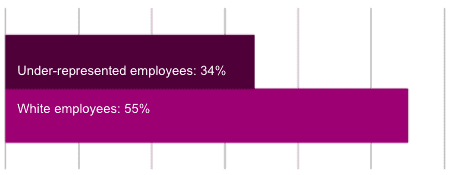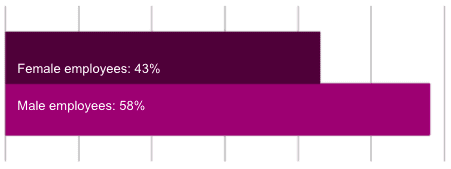Measuring Impact
Measuring Impact
Setting ambitious and attainable goals requires data that show the starting point and progression. Establishing a metrics strategy for DEI efforts within your organization is a critical piece of any organization’s DEI journey.

40%
Companies that do not have metrics to measure the success of their diversity and inclusion efforts.1
9%
Higher EBIT margins in companies with higher than average diversity.2
How might my organization track and use key metrics?
- Use the Sample Metrics in the section below as a start and determine your comparison set (e.g., previous year, industry, internal departments, etc.)
- Collect data through different approaches such as those listed in our Building Capacity for Measurement section
- Leverage data analysis tools like Accenture’s Workplace Accountability Resource Experience (AWARE) enable leaders to use data to define DEI goals, understand how achieving them will deliver quantifiable value, and create a roadmap of initiatives to enable business strategy
Sources: 1 Forbes 2 Harvard Business Review
Sample Metrics
This section contains key metrics to consider as you evaluate your efforts across the talent acquisition process. Please note that this is only one part of a broader ESG strategy, but the intention is to keep this section focused on metrics for the talent pipeline.

Recruitment – Evaluating recruitment efforts allows employers to recognize the efficacy of DEI in their talent acquisition strategy.
- Return on Investment on recruitment events (money spent vs. applications and/or conversions per event)
- Return on investment on workforce development partners and sponsorships
- Applicants and conversions per recruiting contact
- Assess job descriptions for potential biases 3

Application – Measure data associated with all applicants to analyze information about candidate’s pool to get a sense of success and opportunities to address.
- Number of applicants
- Applicant demographics
- Common vs. differentiated skills
- Assess job descriptions for potential biases

Interview – Identifying and reducing potential biases within the hiring process allows employers to get to know the best talent. 4
- Demographic information of interviewees
- Background information of interviewees, such as skills, credentials, etc.
- Demographic information of interviewers

Hiring – Inclusive hiring helps generate employee retention, creativity and overall productivity. Tracking data ensures hiring managers have data to spot trends and potential biases to eliminate.
- Number of new hires
- New hire demographic
- Percentage of each demographic hired
- Demographic of each hiring manager
- Conversions per interviewer / interview team
- Acceptance rate of offers per team/hiring manager/recruiter

Employee Experience – Measuring employee experience can uncover bright additions to an employer value proposition and help attract the best talent; it can also give a clear view of opportunities to address for better conversion and retention. 1
- Level of psychological safety
- Level of trust in managers and leaders 2
- Employee sense of authenticity
- Employee sense of inclusion
- Share of strengths used in role
- Manager satisfaction
- Team satisfaction

Representation – Analyzing the distribution of diversity within your organization can help unearth areas to prioritize, create attainable goals for improvement, and provide guidance on areas to explore further.
- Demographic representation in your firm vs. that of your industry
- Representation in strategic vs. operational roles
- Representation in senior vs. middle vs. entry level roles

Pay Equity – Fair and equitable compensation practices show employees your commitment to equity in action. The following data could help determine focus areas to address: 5
- Salary at each level by demographic and performance ratings
- Percentage of employees from underrepresented groups who are below average salary levels
- Progress over time in equitable compensation

Promotion – Companies need to measure the percentage of underrepresented employees promoted each year in comparison to the percentage of majority groups promoted each year. The data needed will be:
- Rate of promotion from women at each grade level
- Rate of promotion from underrepresented groups at each grade level
- Promotion information from majority groups at each grade level
- % demographic promoted at each grade level

Retention – Companies need to track the attrition rate at each level of seniority to determine where the disconnect if any is happening, employers will need to collect data including: 6
- Demographic at each level of seniority
- Percentage of demographics of employees leaving the company to help determine if the attrition rate is possibly an inclusion problem or job satisfaction problem
- Exit interview data analyzing job satisfaction
Sources
- https://www.forbes.com/sites/nelldebevoise/2021/07/30/how-ceos-can-keep-their-best-people-through-the-great-resignation/?sh=2211dfcd6077
- https://www.accenture.com/us-en/about/inclusion-diversity/culture-equality-research
- https://hbr.org/2017/06/7-practical-ways-to-reduce-bias-in-your-hiring-process
- https://www.forbes.com/sites/hvmacarthur/2020/07/24/hiring-managers–diversity-how-to-take-the-bias-out-of-your-interviewing-process/?sh=67747e3319b9
- https://www.accenture.com/us-en/about/inclusion-diversity/culture-equality-research
- https://www.accenture.com/us-en/blogs/voices-public-service/how-can-you-stop-your-employees-from-leaving
- https://www.accenture.com/_acnmedia/PDF-134/Accenture-A4-GWC-Report-Final1.pdf
Building Capacity for Measurement
Many organizations do not have structured data processes to measure the impact of their DEI journey. This section provides a starting point and leading practices to consider incorporating.
Create an iterative process to measure impact





Step 1
Identify business questions to answer with data
Step 2
Identify which metrics to collect in relation to business questions
Step 3
Collect and analyze data based upon metrics identified in Step 2
Step 4
Use insights from data to create and execute plan to achieve desired outcomes
Step 5
Set regular cadence for revisiting data to track and measure progress / impact of plan
What do we want to know?
Determine areas to explore based upon pain points, strengths, and opportunities within organization:
- Which factors contribute to advancement and retention of our high performers from underrepresented groups?
How will we find it?
Prepare data plan for metrics collection:
- Identify high performers
- Examine their experience and background
- Exposure to opportunities
What did we find out?
Compile and analyze data to identify and draw:
- Identify high performers
- Trends
- Commonalities
- Extreme differences between selected groups
- Hypotheses
What can we do about it?
Leverage insights to create objectives and actionable steps:
- Establish initiatives
- Change processes
- Expand learning and development
- Create partnerships
Did it work?
Establish when and how to assess plan:
- Success based upon objectives
- Updates needed
- Collect more data and metrics
- Frequency of updates
- Communicate results
Methods for Measuring Impact
Finding an outlet to voice workers’ frustrations improves retention. A study found that workers who received a phone call or voice intervention requesting their feedback were 20% less likely to exhibit quitting behavior compared to those that did not.2
Case Study: The Department of Defense uses crowdsourcing to find better ways to promote and improve diversity and inclusion. They created a board comprised of Diversity & Inclusion consultants, leadership, and other stakeholders to provide an outlet for employees to submit feedback and raise important topics anonymously. The board acknowledged the “old ways” have taken them far but new ideas from employees are needed to continue the process of inclusion and promoting diversity in the ranks.3 The Board created a Diversity and Inclusion Report with recommendations and clear next steps to implement and track plans.
Sources:
1. Harvard Business Review
2. Forbes
3. US Department of Defense
A few internal data trends and metrics organizations assess1:
– gender pay gap
– generation gap
– racial inequities
Case Study: Starbucks pays particular attention to compensation data in their mission to achieve 100% pay equity for women and men. As of March 2018, Starbucks has reached 100% pay equity for partners of all genders and races performing similar work across the USA. Starbucks achieved this milestone by creating equal footing from the start and throughout an employee’s career. They do not ask candidates about their salary history, as their starting pay is based on a candidate’s skills & abilities. They also maintain a culture of transparency and accountability amongst employees, to preserve pay equity globally.2
Sources:
1. Harvard Business School
2. Starbucks
According to research, inclusive teams make better business decisions up to 87% of the time. Teams that follow an inclusive process make decisions two times faster with only half of the meetings. 1 Decisions made and executed by diverse teams also delivered 60% better results. Compared to individual decision makers, all-male teams make better business decisions 58% of the time, while gender diverse teams do so 73% of the time. Teams that also include a wide range of ages and different geographic locations make better business decisions 87% of the time.2
Case Study: Allstate frequently seeks ERG leadership input to ensure they address inclusion and diversity issues internally and externally. They use current ERG relationships with external organizations to enhance the diversity of their hiring pipeline including, National Society of Black Engineers, Society of Women Engineers, Association of Latino Professionals For America, etc. In 2021, 30% of new hires were from underrepresented groups, increased from 19% in 2016.2
Sources:
1. Building Sustainable D&I (Gartner)
2. Allstate
Recent research shows, 68% feel they create empowering environments—in which employees can be themselves, raise concerns and innovate without fear of failure— but just 36% of employees agree. In addition, employees care increasingly about workplace culture and believe it’s important to help them thrive in the workplace (reported by 77 percent of women and 67 percent of men).3
Case Study: The HEINEKEN Company conducts “climate surveys” to track the evolution of employees’ perception of inclusion.4 HEINEKEN takes time to understand people’s remarks and concerns and act in response. HEINEKEN now offers a female sponsorship program that supports women in their personal development journey across the organization and embeds inclusion and diversity principles throughout its people processes, including external recruitment, promotions, and working practices. Female representation at HEINEKEN has grown over the years from 16% to 23%.5
Sources:
1. Accenture – Decoding Organizational Data
2. Harvard Business Review
2. Gartner (HR)
3. Accenture – Culture of Equality in the Workplace
4. LinkedIn
5. HEINEKEN










